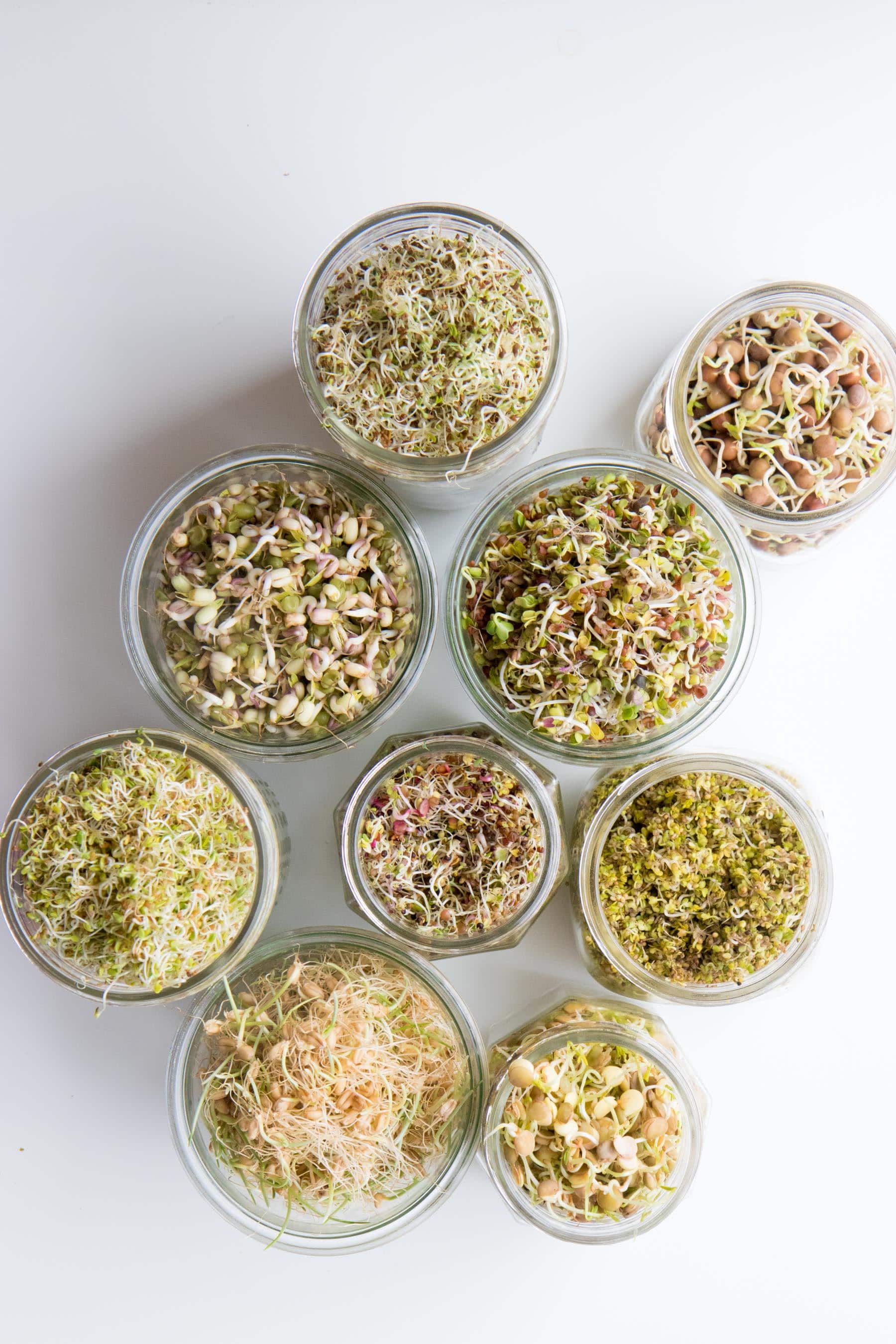Everything you’ve ever wanted to know about sprouting, including what sprouts are, why you should try them, and how to sprout.
Was anyone else really big into sprouting beans when you were a kid? I’m talking the whole put a bean on a damp paper towel inside of a zip-top bag kinda deal. I always loved doing that. I thought it was so much fun to see this little unassuming bean go from, well, a little unassuming bean into something alive and green. Once the beanstalk was a certain size, my parents would help me transfer the little dude into a pot with some soil and we’d continue to watch him grow.
Eventually, something more interesting would always come along (Sonic the Hedgehog! A new Ghostwriter episode! A movie where Devon Sawa shows his butt!) and my foray into horticulture would end. But fast forward to now, and my love of sprouting things comes in so handy in my kitchen!
I’ve been collecting your sprouting questions for a few months now, and we have a lot to cover in this post, so I’m going to dive right in!
What are the benefits of sprouting?
Sprouts are one of the easiest foods you can grow indoors. They require barely any space—if you can fit a Mason jar on your counter, then you have enough space. You don’t need any special equipment. And heck, you don’t even need a sunny window! Sprouts are a veggie that everyone can (and should) grow.
Aside from the fact that sprouts are an easy, cheap, and tasty vegetable anyone can grow, sprouting also has some real nutritional benefits. Sprouting legumes, grains, and seeds makes them much easier to digest by breaking down the anti-nutrients that are common in those foods. If you’ve ever had troubles digesting a particular grain or legume, I highly recommend trying it sprouted before writing it off all together. You might be pleasantly surprised that sprouted beans or grains don’t bother your body! In general, sprouting also increases the vitamin C and B content and the fiber! Sprouts rock.
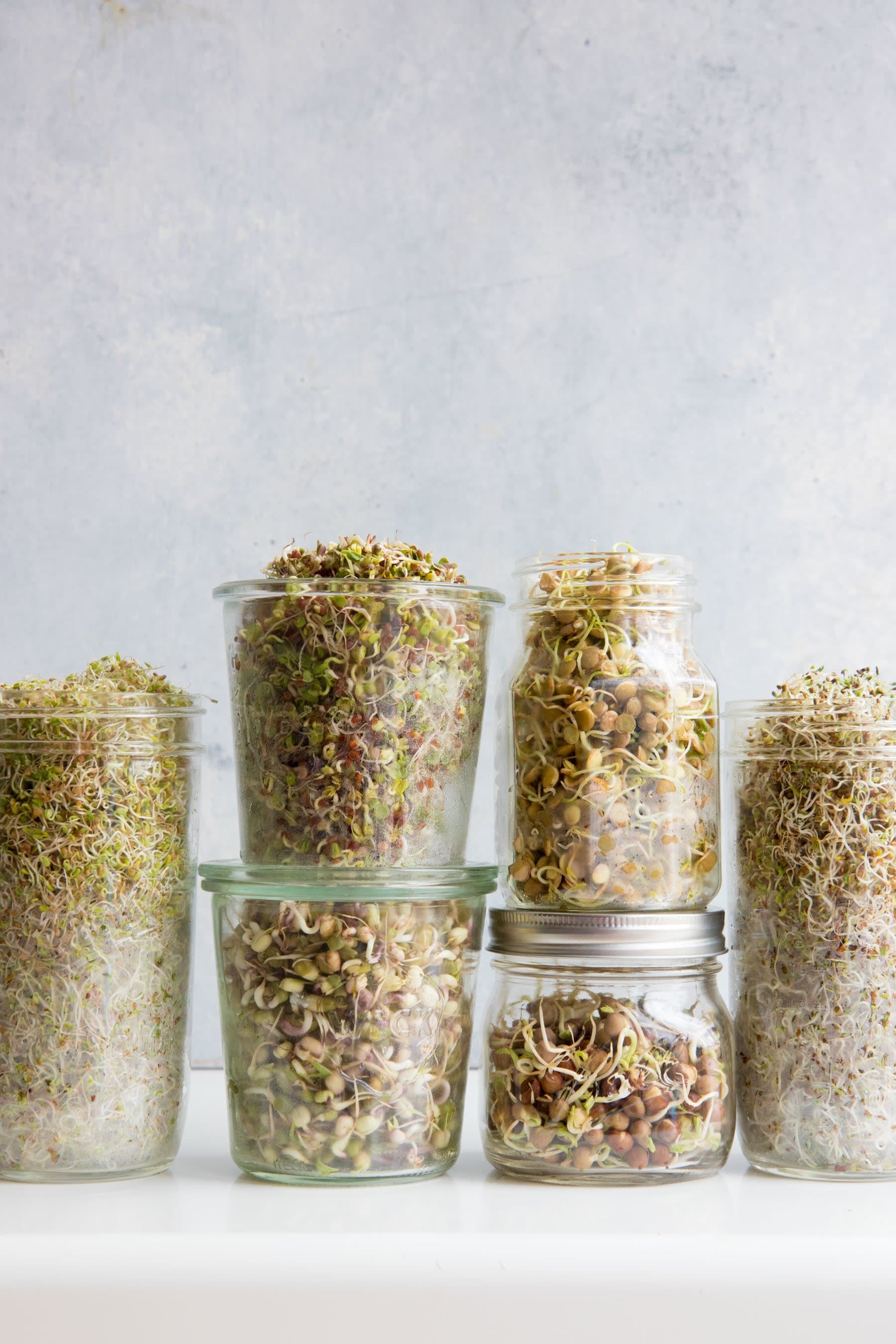
Is it safe to sprout?
I know a lot of folks are worried about sprouting safety because there have been so many outbreaks of salmonella and e.coli associated with sprouts from the grocery store. Why is this the case? Well, the warm humid environment that sprouts grow in is also the prime climate for bacteria to spread. In large-scale commercial operations, it’s almost impossible to keep the environment clear from all types of pathogens.
But luckily for you, the chance of getting a food-borne illness with sprouts is greatly diminished when you sprout at home. You control the seeds you use (and if they’ve been tested to be free of salmonella and e.coli). You control if your sprouting jar is clean or not. You control how much air circulation your sprouts get. You control who touches the seeds (and if they wash their hands first). You control how long the sprouts stay in the jar before being rinsed.
Basically, I never buy sprouts from the store (or get sprouts out a restaurant), but I’ve been happily eating sprouts grown at home for a decade now without a lick of trouble. And if you’re still concerned, you can always cook your sprouts to put the final nail in the coffin of any leftover bacteria.
What can I sprout?
You can sprout almost any legume, seed, or nut. Everything from chickpeas to broccoli to millet to radish to red clover to mung beans. There are a few exceptions—not because they won’t grow a sprout, but because the effort required to get it “right” isn’t really worth it or because they aren’t good for you.
Chia seeds, flax seeds, and other mucilaginous seeds (the ones that create the goo) are tricky to sprout properly. You definitely can do it, but I generally just avoid it because there are so many other seeds that are way easier to sprout.
Avoid sprouting kidney beans for raw eating. They contain a toxin that causes nausea, vomiting, and diarrhea in many folks. If you do choose to sprout kidney beans, make sure to boil the finished sprouts for at least 10 minutes before consuming them.
Quinoa contains a high concentration of saponins, which in some folks causes a strong allergic reaction that makes them feel ill.
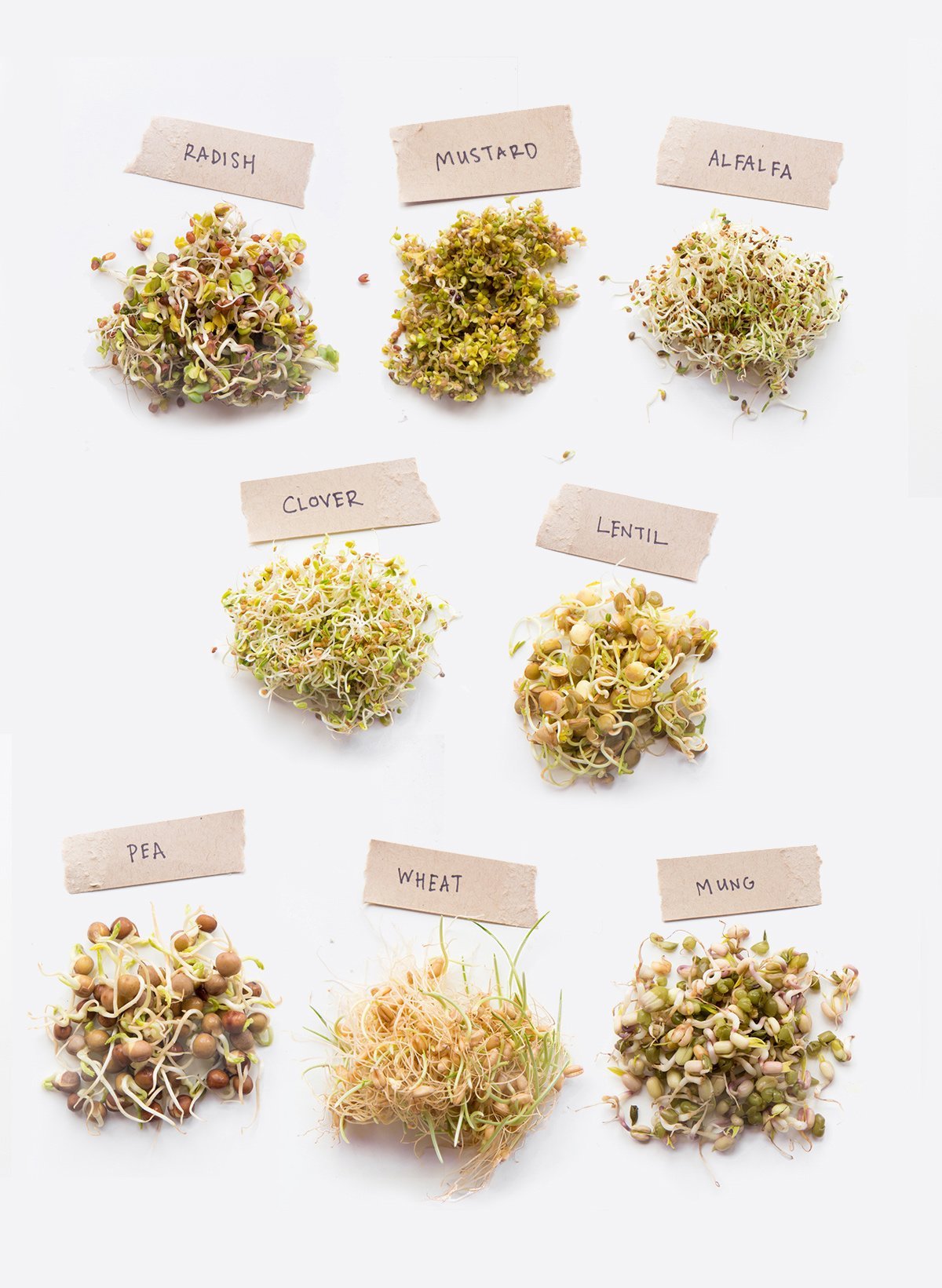
Nuts like almonds don’t actually make sprouts, they make “soaks,” which is what it’s called when a seed doesn’t produce a root during the sprouting process. They are still delicious, and the soaking process helps break down the anti-nutrients (so digestion is easier) and makes them a healthier choice. Then if you like, you can dehydrate them if you want crunchy snacking nuts.
Do I need special sprouting seeds?
Technically, no. You can walk into the grocery store and pick up a bag of lentils, and chances are, they’ll sprout fine. BUT, I recommend you buy sprouting specific seeds for two reasons:
Here in the States, many foods that come in from other countries are irradiated to stop sprouting before they hit our grocery store shelves. This means that no matter how well you take care of your seeds, they are never going to sprout.
Sprouting seeds are all tested and verified to be free of e.coli and salmonella. Growers of sprouting-specific seeds take great care to make sure the seeds they sell are very clean—meaning they are free of harmful bacteria and other pathogens that can thrive in the sprouting environment. That bag of lentils you picked up from the grocery store? The packagers of that were assuming your plan was to boil them at high heat—which would kill any pathogens. Sprouting seed providers know that isn’t the plan for their seeds and adjust their growing and packaging processes accordingly.
Where do I get sprouting seeds?
My local health food store carries some packets of sprouting seeds, but the vast majority of my sprouting seeds I purchase online. I’ve ordered sprouting seeds and mixes from Johnny’s Seeds (I really like their Organic Sprout Mix). But far and away, my favorite place to order sprouting seeds is from Sprout People. They have an amazing selection of varieties, mixes, and tools. I’ve also been really impressed with their germination rates and how long the seeds stay viable. I have a few bags from them that are going on three years old—and they sprout just as well as they did the day I go them.
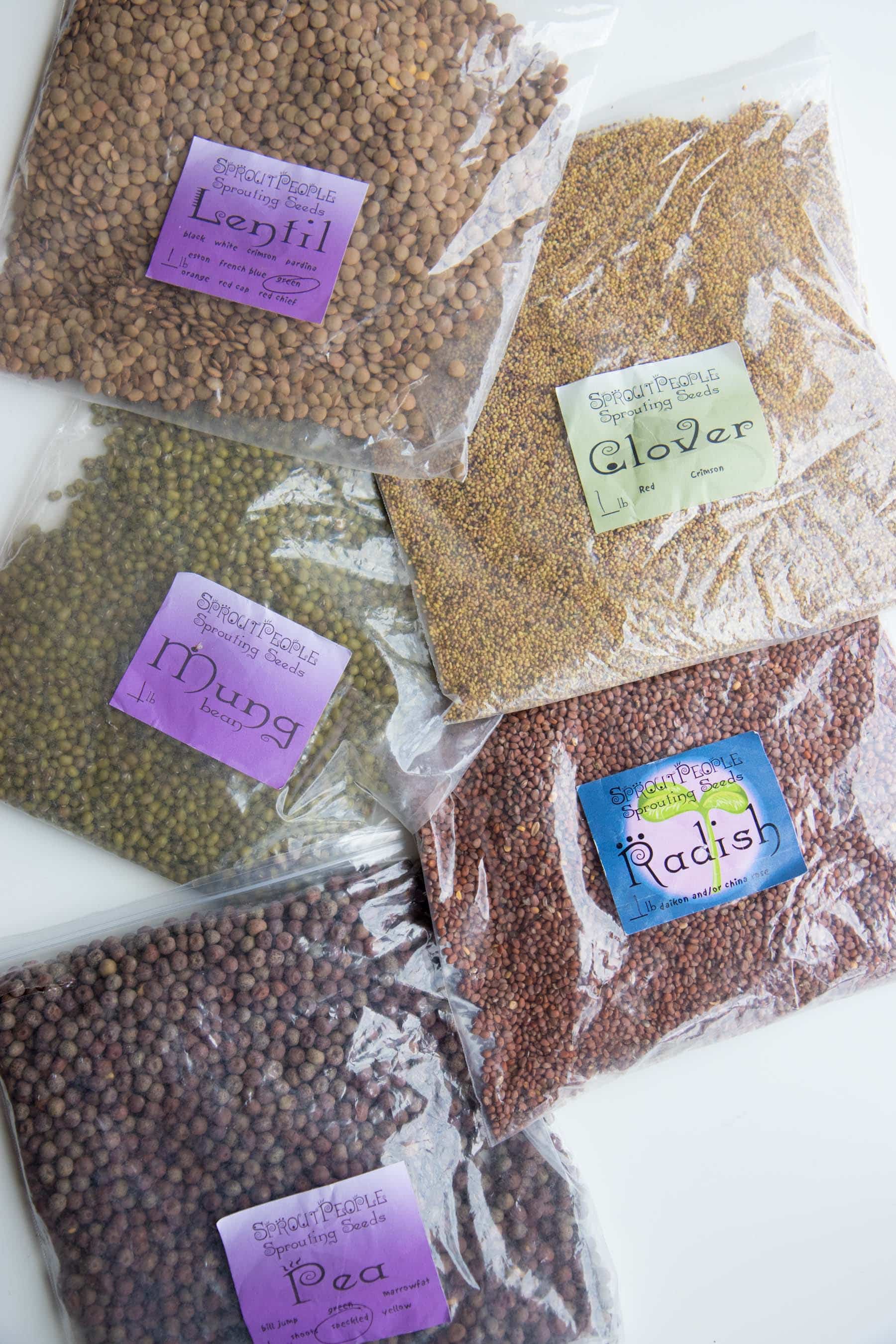
Do I need special tools?
Nope. To get started, all you need is a large clear jar (you don’t even need a lid), a small piece of natural, breathable fabric (cotton and cheesecloth both work), and a rubber band. That’s it. We tend to use wide mouth quart Mason jars for most sprouts, but sometimes we’ll also do wide mouth half-gallon Mason jars if we want a lot of sprouts. If you find yourself enjoying sprouting, then I do recommend spending the few bucks on these sprouter lids that fit on wide-mouth Mason jars. They make the rinsing and draining process ever so slightly easier.
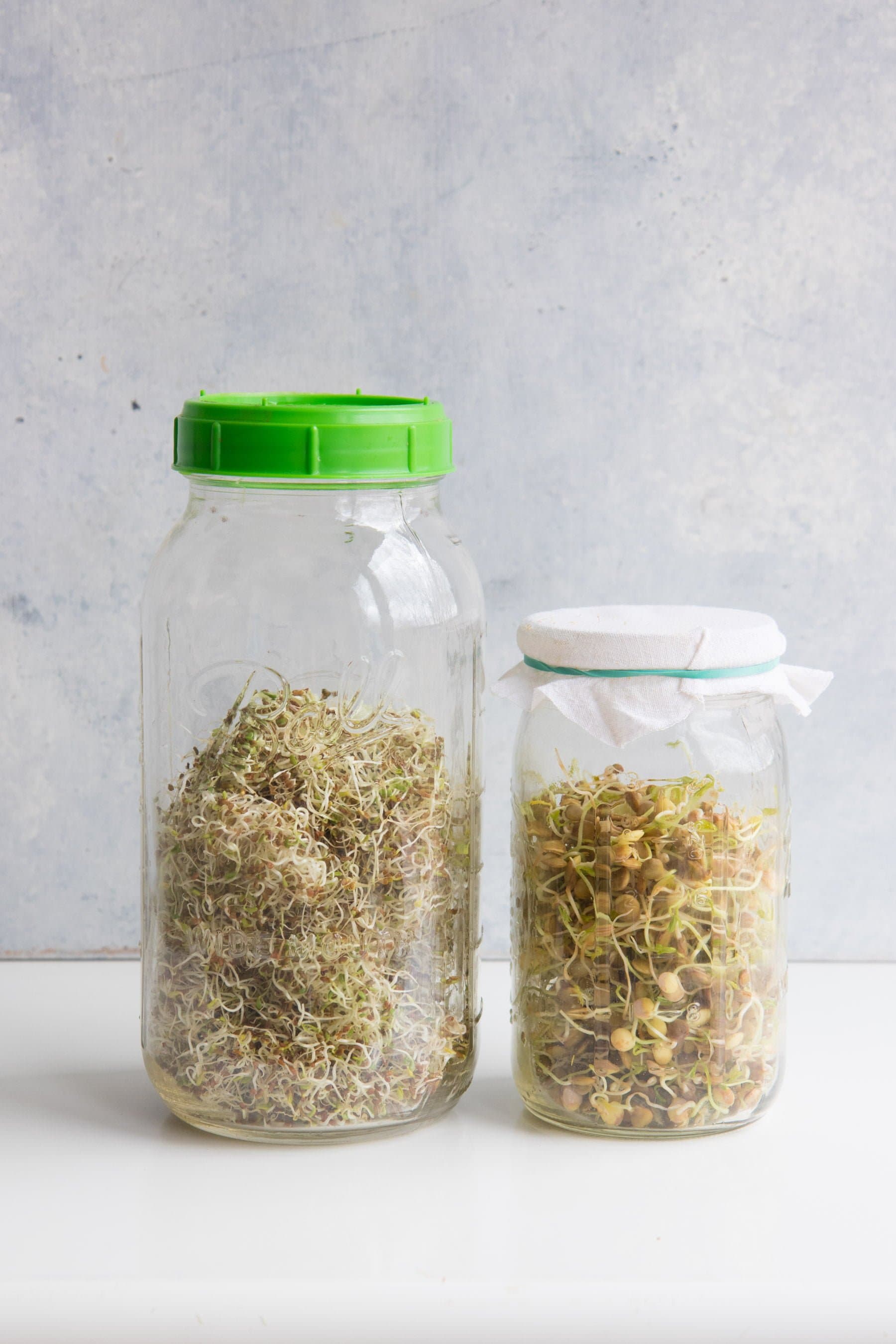
Can my fur-and-feather babies eat sprouts, too?
Oh, heck yes they can! Chickens, in particular, will devour sprouts like it’s their job (which it kinda is—to turn those sprouts in my eggs for breakfast). During the winter, I like to grow a few batches of sprouts per month for the chickens to get them some fresh food. We like these bird mixes from Sprout People and this foraging mix from Peaceful Valley (we also plant that foraging mix).
Dogs and cats are less apt to eat seed sprouts themselves, but they do love themselves some wheat grass—which just means you need to let your wheat sprouts grow a little bit longer!
Can I make sprouted grain flour at home?
Sure can. Follow the process below for whatever grain you want to use (wheat, rye, etc.), but only let your seeds just begin to sprout—you’re looking for at most 1/4” of a sprout. Then place them in a food dehydrator on the lowest setting until completely dry—about 24 hours. Grind in a grain mill, and voila, homemade sprouted grain flour! You’ll probably want to do a larger volume of sprout (using a half gallon jar works) to make enough for baking.
Okay, how do I actually sprout?
The sprouting process is a breeze. Let me walk you through it:
Step 1: Soak your seeds
Different seeds will soak up different amounts of water, but a good general rule is to use three parts water to one part seed. How much seed do you use? Well, it depends on the seed, the size of your container, and how much sprouts you want in the end. I made a handy-dandy little chart for some of the most common kinds of sprouts (you can click to enlarge and print).
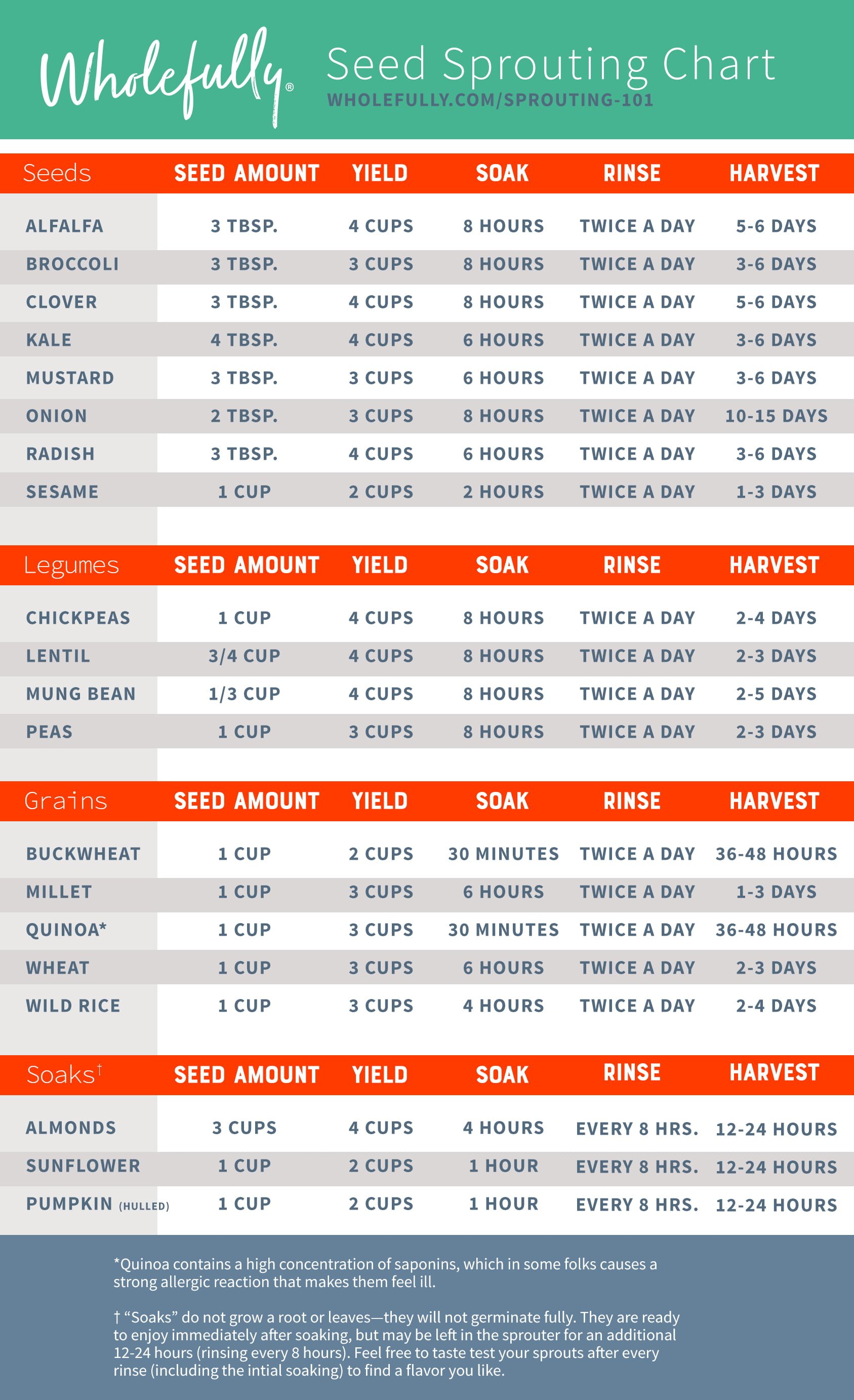
Place the seed in a clean Mason jar, cover with cool water, and then stir to make sure all seeds are wet. You can leave the jar open (that’s what I normally do), or you can cover it with either a sprouter lid on top of the jar or a piece of breathable natural fabric (like cheesecloth or muslin) secured with a rubber band. Set it aside to soak for the listed amount of time.
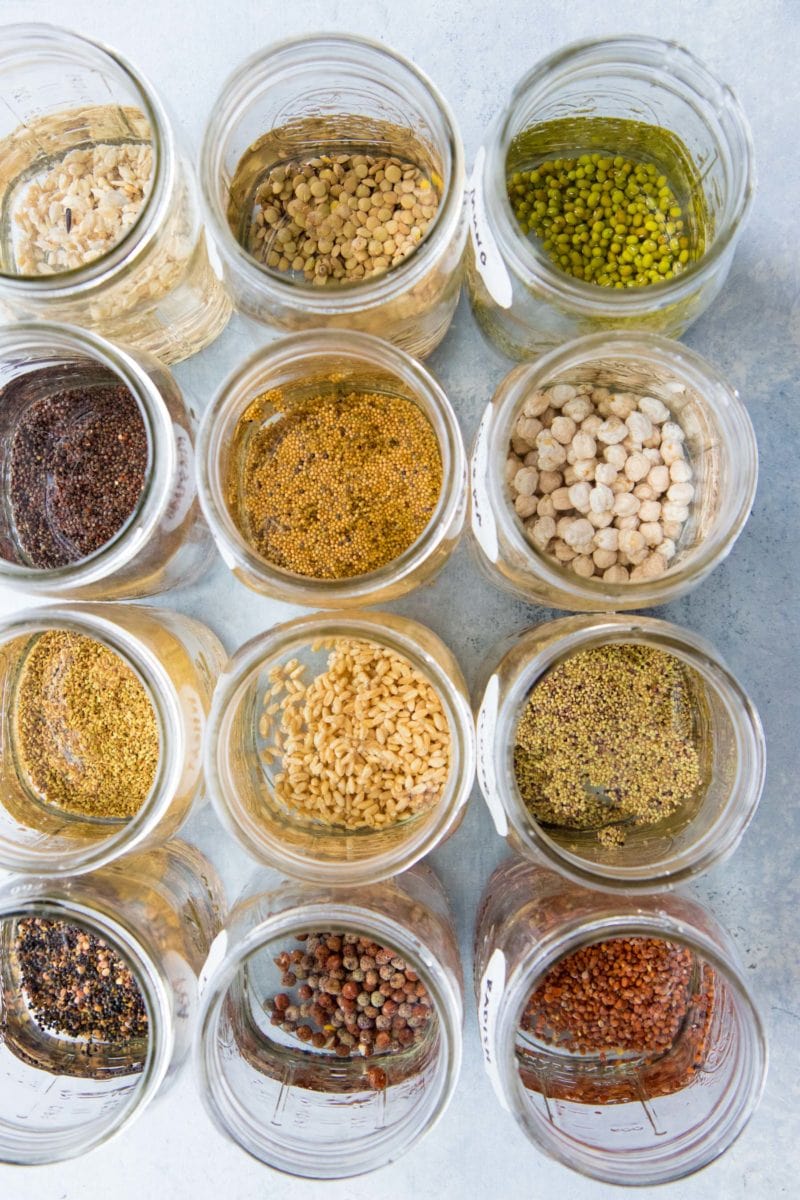
A note about soaking: you don’t really need to stress about soaking precisely what’s listed in the chart. You aren’t going to mess your sprouts up if you soak for ten hours instead of eight.
Step 2: Drain and rinse your sprouts
Once the soaking time is up, you need to drain your sprouts. If you have a sprouter lid, just tip the whole jar over the sink and let the water rush out. If you used the cloth method, remove the rubber band and cloth, and place a fine mesh sieve over top of the jar. Invert it over the sink and let drain.
Then add more fresh, cool water to the jar, swirl it around a little bit, and rinse out that water. Make sure to really shake out as much water as you can.
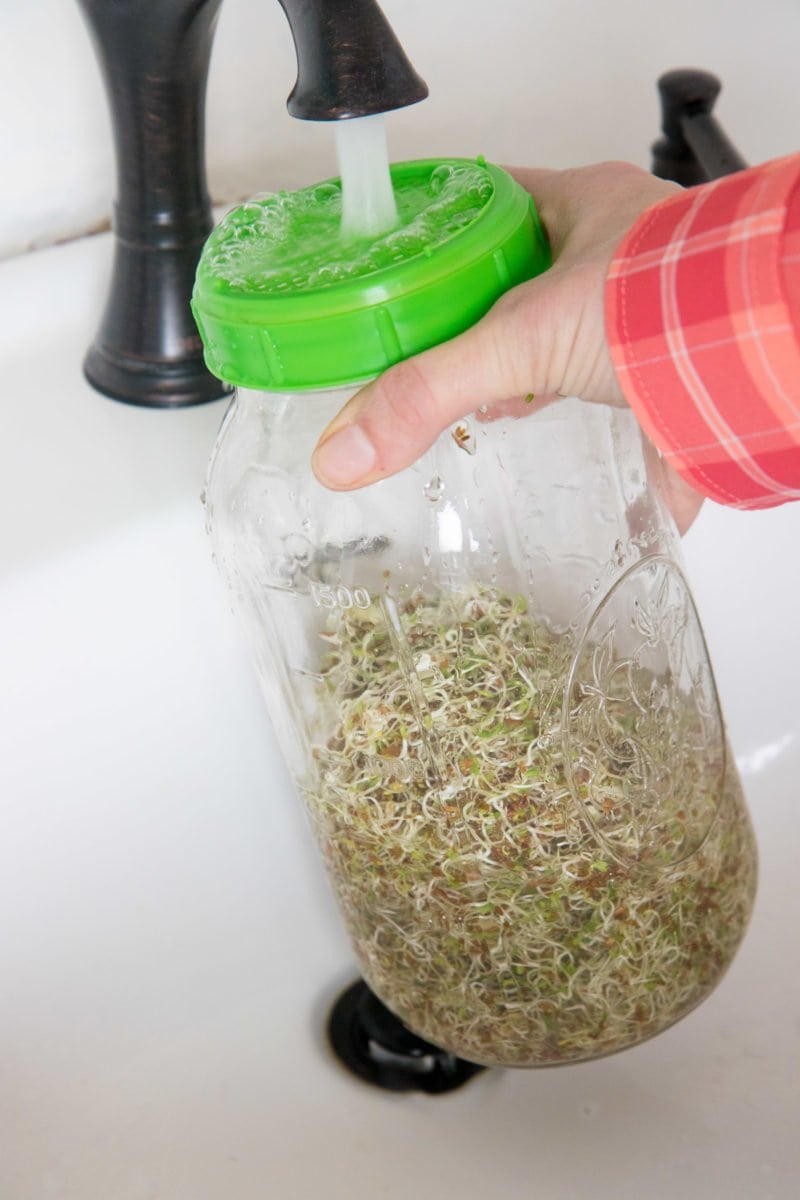
Once the sprouts are all rinsed, I like to turn the jar in my hand so as many seeds as possible stick to the outside of the jar. This tends to get a bit better of a germination rate for me. Then prop the jar, upside-down, in a bowl, like so:
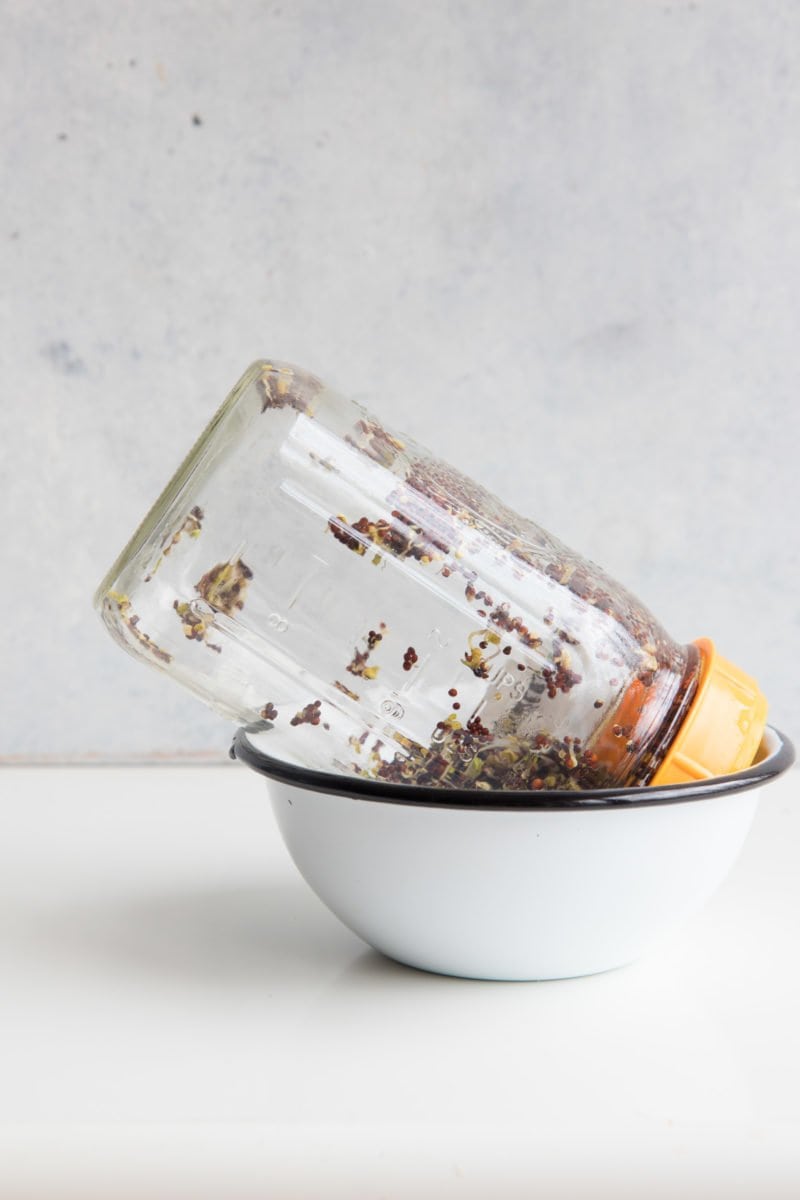
It’s important to keep the sprouts draining nicely, and this little trick seems to do it well. Set it in an out-of-the-way-but-not-forgettable spot. It doesn’t need to have sunshine (although, it doesn’t hurt), but it does need to be able to breathe. So I wouldn’t recommend storing it in a cabinet. I just do my sprouts on my kitchen counter.
Step 3: Rinse, drain, repeat.
Now your only job is to visit your sprouts twice a day (for most sprouts) and rinse them with fresh, cool water, drain, and prop back up in the bowl (you might want to empty out the water that collected in the bowl at this point, too).
For most seeds, you’ll start to see little baby sprouts within a day or so. You can honestly harvest and eat your sprouts at any stage, but most folks prefer to harvest sprouts that are 1/2-2” long. Keep on rinsing and draining until you get to the length you want.
Step 4: Harvest, store, and use your sprouts!
You’re ready to harvest…now what? Give your sprouts one final rinse and drain, then remove the jar lid and dump all the sprouts out onto a clean, absorbent kitchen towel. Spread them all out onto one layer and let them air dry for 30-60 minutes before storing.
To store: I like to line a glass food storage container with a clean tea towel (paper towels work too) and then put the sprouts in. Then I wrap the sprouts up and close the container. Extra moisture is the enemy of sprouts (and most produce—this trick also works with herbs, lettuces, and other greens). Store in the fridge for up to a week.
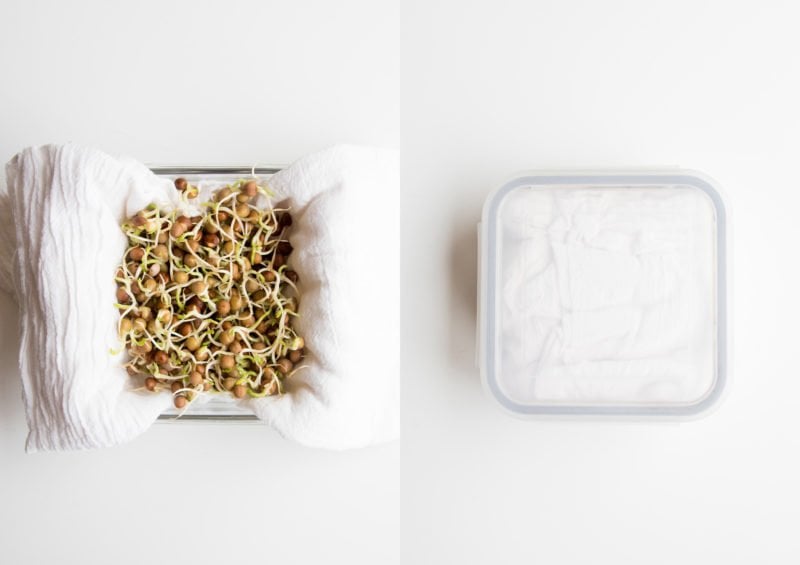
You can now use your sprouts in any way that pleases you. I love them on sandwiches, in wraps, on salads (or even as the entire base of a salad). Bean sprouts are great in stir fries, frittatas, and scrambles. The possibilities are endless!
Optional Step 4a: Rinse away the hulls
I almost never do this, but some people like to rinse away the hulls (the outer seed coatings) on their sprouts once the sprouts are finished. Here is a great tutorial on how to rinse away the hulls with a salad spinner.
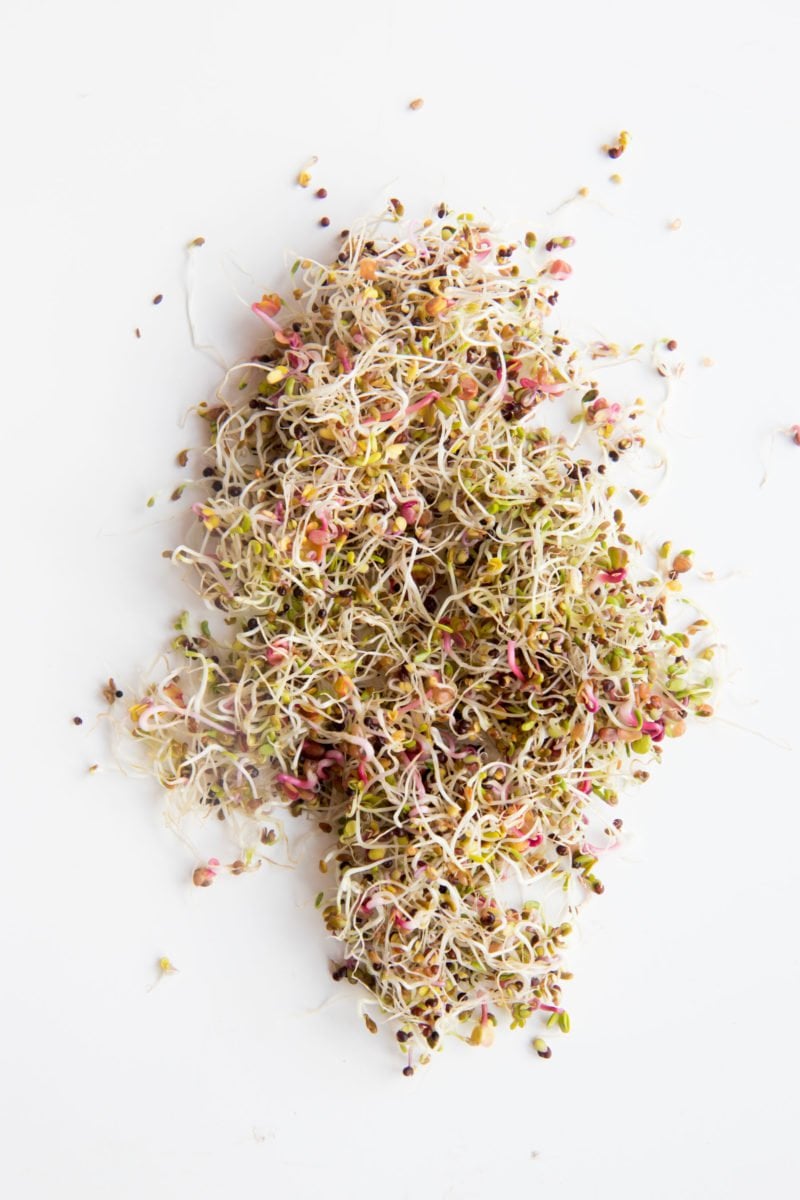
Troubleshooting
Why do my sprouts always go moldy?
Guess what? There is a very strong chance that your sprouts aren’t moldy at all, you’re just seeing the fine root hairs that look A LOT like mold. Like, a lot, a lot. Root hairs start to show up when the sprout is at its driest (and that’s why you see them when you go to rinse your sprouts again). If you use clean seeds, a clean sprouter, and make sure air is circulating (don’t keep your sprouts in a cabinet), the chances of having moldy sprouts is pretty slim. And yes, this applies to high humidity climates, too. I’ve sprouted without mold even in those glorious 90%/90° Indiana summer heat waves.
How do you tell the difference between mold and root hairs? Well, when you rinse your sprouts, does all the “mold” magically disappear? If so, then it’s root hairs. The water makes the fuzz fall back against the main root until they dry out again. You can also tell because mold smells! Root hairs don’t. Use your sniffer.
Fruit flies are all over my sprouts! What do I do?
Sigh. Fruit flies are a natural (and annoying) part of having fresh produce—including sprouts—in your life in the summertime. We use apple cider vinegar fruit fly traps to try to keep the population down, but just accept that we’re going to have some houseguests for the warm weather months. To keep fruit flies out of your sprouts, I recommend using the cloth method instead of sprouting lids. The cloth keeps the fruit flies out, but they can fly through the sprouting lids. If you do notice fruit flies flying in and out of your sprouts, I’d recommend composting the batch and starting again (although, I hear insects are a good source of protein…).
I think my sprouts have gone bad in the fridge, how do I know?
Again, use your sniffer! Bad sprouts smell “off” and rancid. Many sprouts will also start to rust right before they go bad—so if they don’t smell bad but suddenly look a bit rusty or brown, make sure to use them up that day. In general, fresh sprouts can keep around a week in the fridge when stored properly.
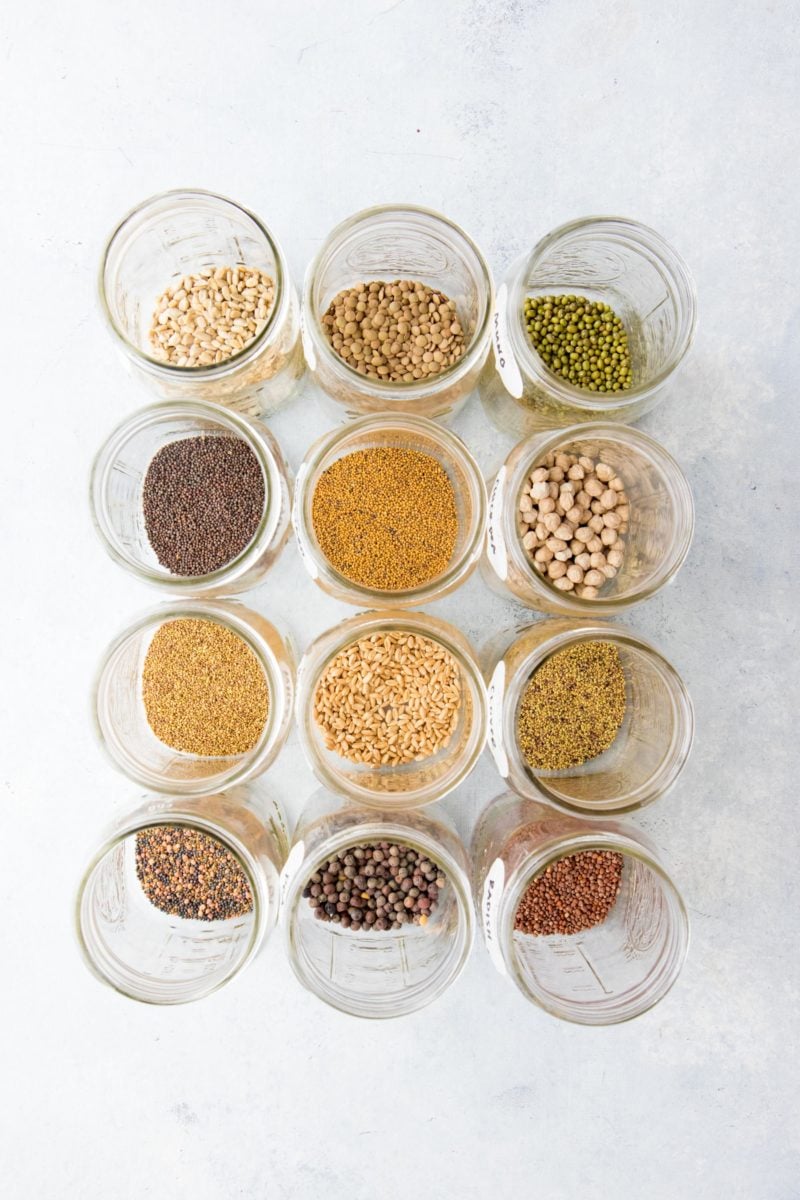
Phew, did you make it through all of that? If so, you are completely well-versed in the world of sprouting and ready to go order yourself some seeds and get going! As always, if you have any questions, leave a comment below, connect with me on social media, or shoot me an email. Happy sprouting!

